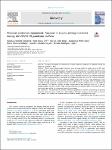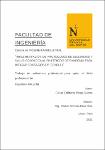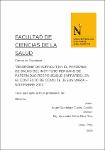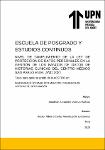Mostrar el registro sencillo del ítem
Personal protective equipment: Analysis of supply among midwives during the COVID-19 pandemic in Peru
| dc.contributor.author | Valverde Espinoza, Natalia | |
| dc.contributor.author | Barja Ore, John | |
| dc.contributor.author | Solis Rojas, Mirian | |
| dc.contributor.author | Pérez Silva, Margarita | |
| dc.contributor.author | Herrera Málaga, Rocío | |
| dc.contributor.author | Huamán Angulo, Lizardo | |
| dc.contributor.author | Rodríguez López, Brenda | |
| dc.date.accessioned | 2023-10-17T23:50:23Z | |
| dc.date.available | 2023-10-17T23:50:23Z | |
| dc.date.issued | 2023-01-04 | |
| dc.identifier.citation | Valverde, N., Barja, J., Solis, M., Pérez, M., Herrera, R., Huamán, L., & Rodríguez, B. (2023). Personal protective equipment: Analysis of supply among midwives during the COVID-19 pandemic in Peru. Midwifery, 118, 103583. https://doi.org/10.1016/j.midw.2022.103583 | es_PE |
| dc.identifier.other | . | es_PE |
| dc.identifier.uri | https://hdl.handle.net/11537/34571 | |
| dc.description.abstract | Objective: To report the details of provision of personal protective equipment to midwives during the COVID-19 pandemic in Peru Methods: This is a non-experimental, descriptive, cross-sectional study. An online survey of 679 midwives working at public healthcare centres was conducted via questionnaires. The following aspects were outlined: method of supply and frequency of delivery of personal protective equipment, type of personal protective equipment provided by the institution, and self-purchase. Furthermore, features of the midwives’ workplace were described. For statistical analysis, absolute frequencies and relative proportions were used for categorical variables, and mean and standard deviation were used for numerical variables. Measurements and findings: The most important finding of this study is that a large proportion of midwives (66.6%) did not receive new personal protective equipment for each shift; 41.9% of midwives who received personal protective equipment during each shift exclusively provided services in the COVID-19 ward, whereas 27.6% did not. The least received supplies were of N95 respirator masks (41.7%) and disposable isolation suit gown (50.5%). Only a certain proportion of midwives (38.6%) were trained by their own institutions on the use of personal protective equipment. Key conclusions: The provision of personal protective equipment to midwives and training on personal protective equipment were insufficient at all workplaces. Therefore, measures must be taken to increase the supply of this material to midwives who are essential workers in reproductive health. | es_PE |
| dc.format | application/pdf | es_PE |
| dc.language.iso | eng | es_PE |
| dc.publisher | Churchill Livingstone | es_PE |
| dc.rights | info:eu-repo/semantics/openAccess | es_PE |
| dc.rights.uri | https://creativecommons.org/licenses/by-nc-sa/3.0/us/ | * |
| dc.source | Universidad Privada del Norte | es_PE |
| dc.source | Repositorio Institucional - UPN | es_PE |
| dc.subject | Personal protective equipment | es_PE |
| dc.subject | COVID-19 | es_PE |
| dc.subject | Midwifery | es_PE |
| dc.subject | Health services | es_PE |
| dc.title | Personal protective equipment: Analysis of supply among midwives during the COVID-19 pandemic in Peru | es_PE |
| dc.type | info:eu-repo/semantics/article | es_PE |
| dc.publisher.country | PE | es_PE |
| dc.identifier.journal | Midwifery | es_PE |
| dc.description.peer-review | Revisión por pares | es_PE |
| dc.subject.ocde | https://purl.org/pe-repo/ocde/ford#3.02.02 | es_PE |
| dc.description.sede | Los Olivos | es_PE |
| dc.identifier.doi | https://doi.org/10.1016/j.midw.2022.103583 |







